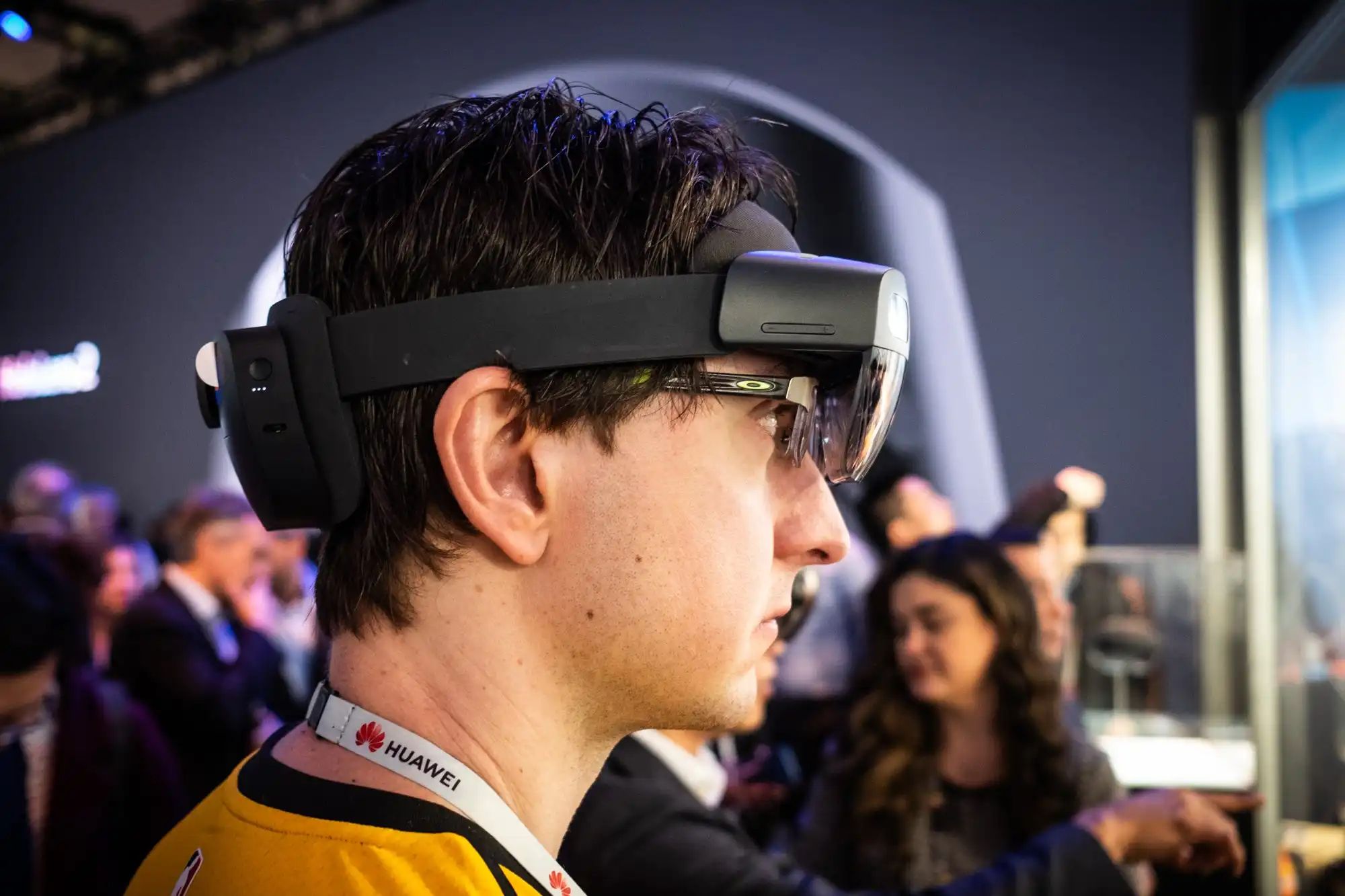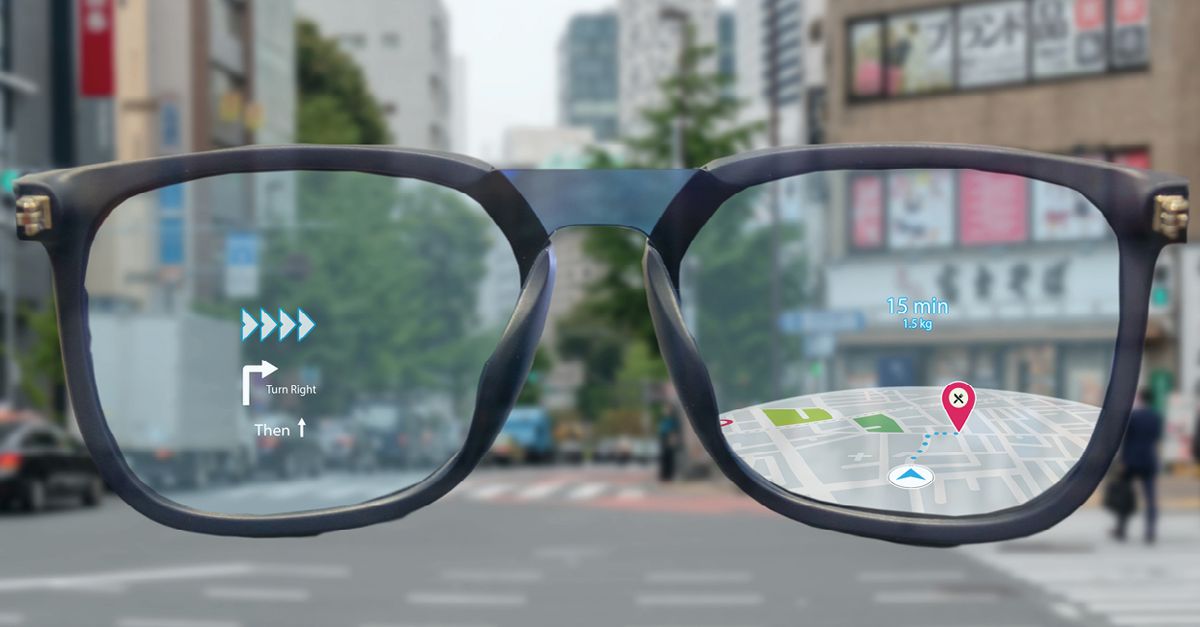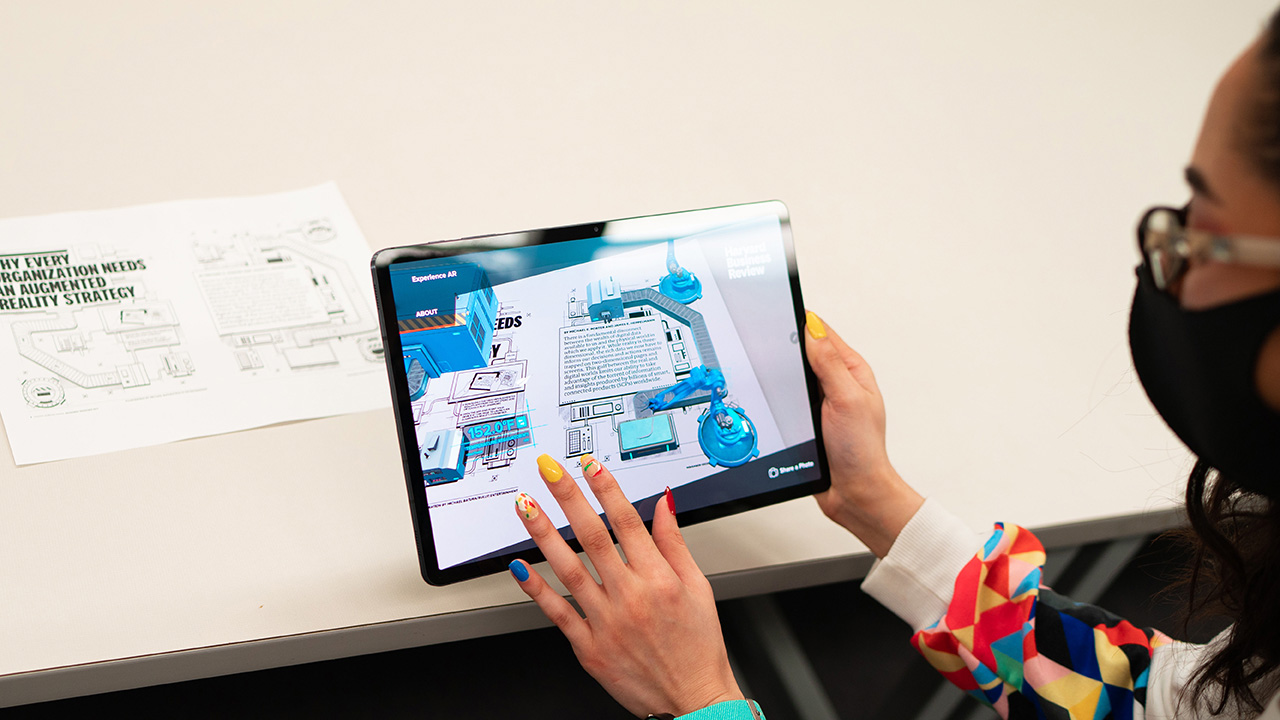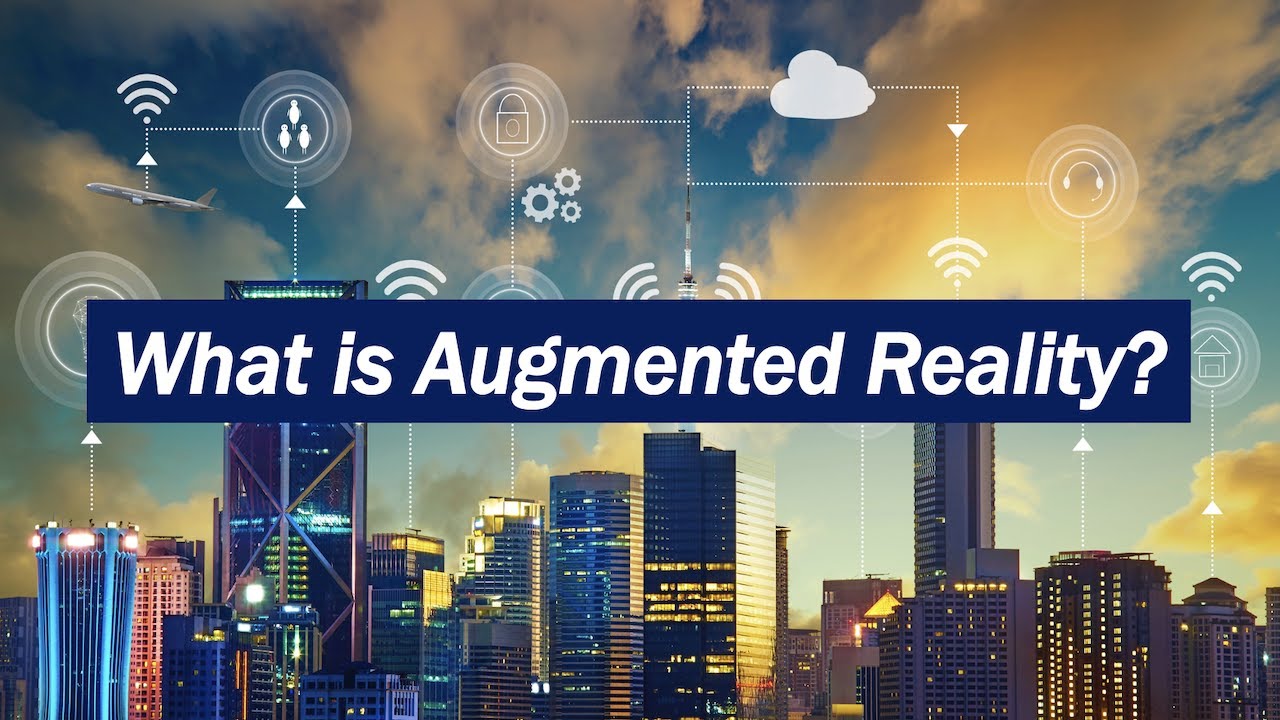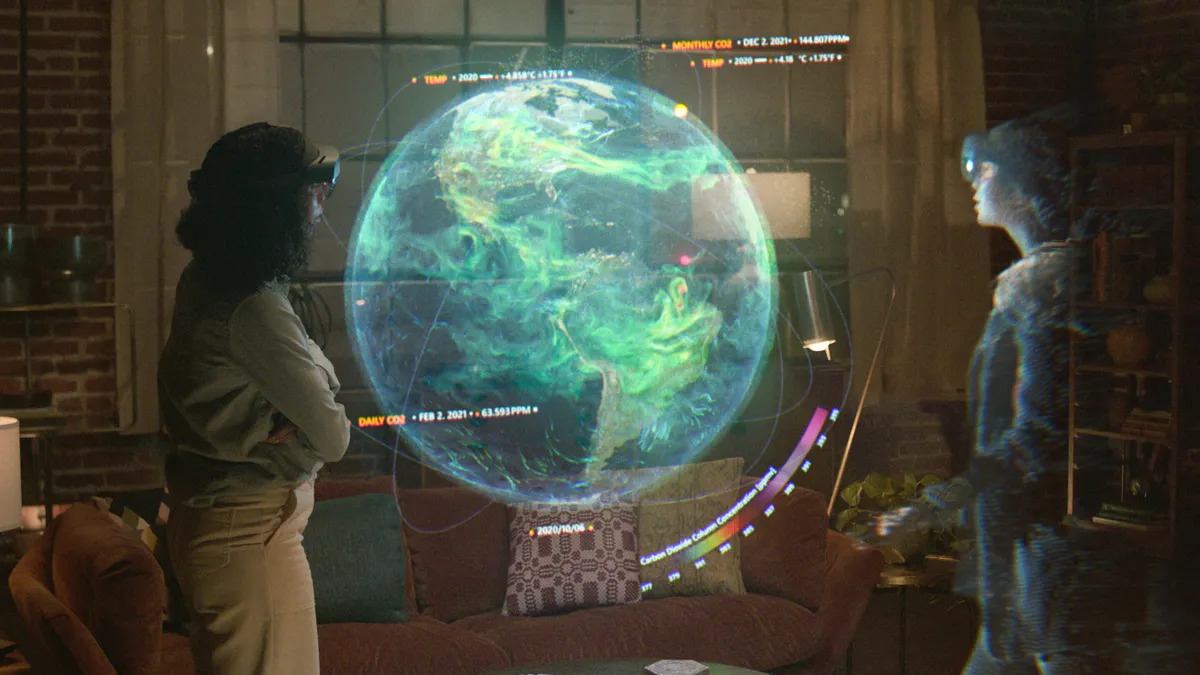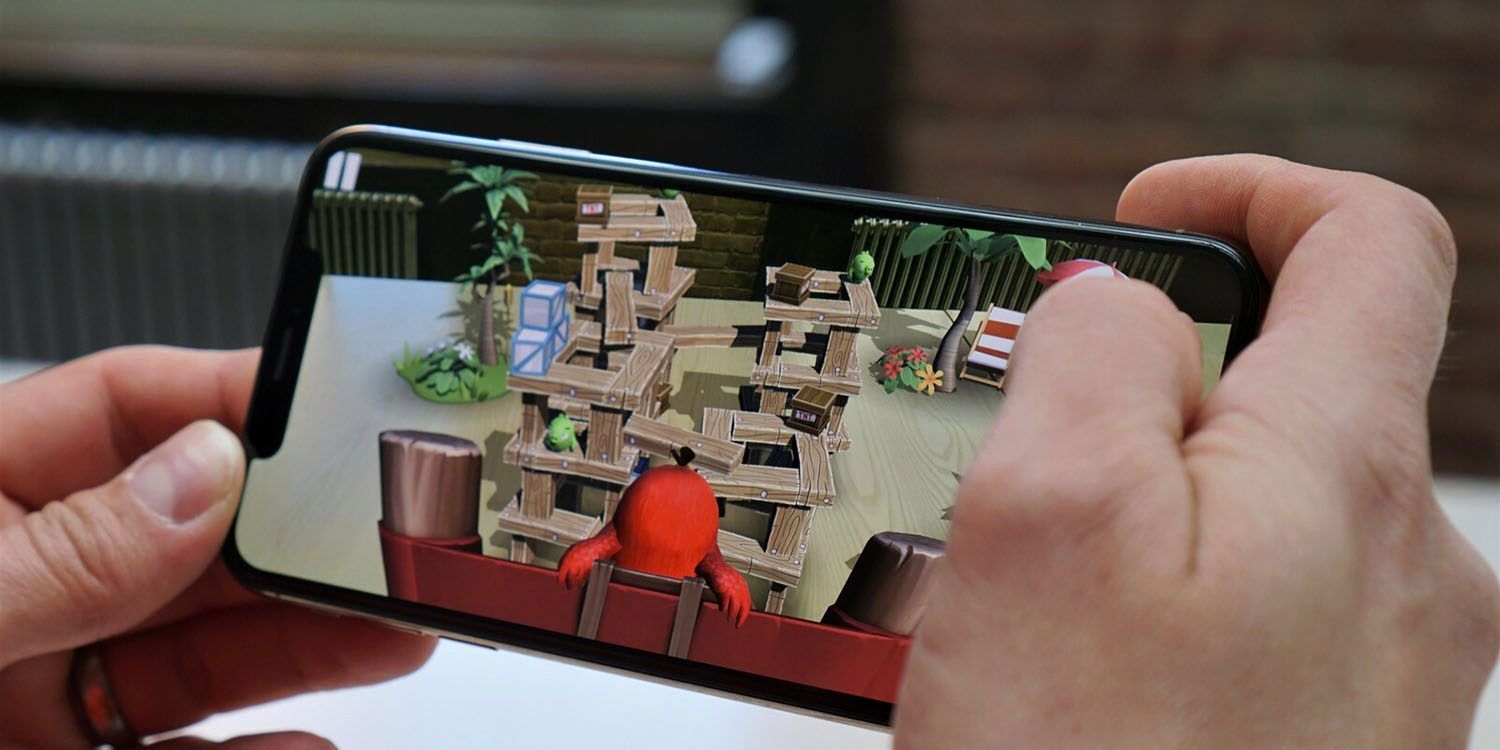Introduction
Welcome to the fascinating world of augmented reality (AR). In recent years, this innovative technology has garnered significant attention and has the potential to revolutionize the way we perceive and interact with the world around us. AR combines the digital and physical realms, overlaying computer-generated content onto our real-world environment, enhancing our sensory experiences and opening up a realm of possibilities.
As technology continues to advance at a rapid pace, the use of augmented reality is becoming more prevalent in various industries, including gaming, education, healthcare, marketing, and more. It offers an incredible opportunity to bridge the gap between the virtual and real worlds, blurring the boundaries of what was once thought possible.
By seamlessly integrating digital information into our physical reality, augmented reality enhances our perception and understanding of the world. It allows us to manipulate and interact with digital objects as if they were physically present, creating immersive and engaging experiences.
Imagine walking through a museum and being able to view interactive 3D models of ancient artifacts or exploring a virtual anatomy model that provides a deeper understanding of the human body. These are just a few examples of how augmented reality can enhance our learning experiences and provide a new dimension to our interactions.
Moreover, AR has the potential to transform how we communicate and collaborate. It enables us to share our experiences with others in real-time, regardless of geographical barriers. Through AR-powered video conferencing or collaborative platforms, we can overlay digital content onto our shared environment, facilitating enhanced teamwork and knowledge sharing.
Despite being relatively new, augmented reality has already demonstrated its versatility and potential. However, there is still much untapped potential to be explored. In this article, we will delve deeper into the world of augmented reality, exploring its definition, history, current applications, technological advancements, and the future potential it holds. We will also address the challenges and ethical considerations associated with this technology.
So, fasten your seatbelts and prepare to embark on an exciting journey into the future of augmented reality, where the boundaries between the virtual and physical worlds continue to blur, and the possibilities are limited only by our imagination.
Definition of Augmented Reality
Augmented Reality (AR) is a technology that blends the physical world with computer-generated digital information, allowing users to experience an enhanced reality. Unlike virtual reality, which immerses users in a completely computer-generated environment, augmented reality overlays digital content onto the real world.
AR enhances our perception of the physical environment by adding contextually relevant digital information in real-time. It achieves this through the use of various devices, such as smartphones, tablets, smart glasses, or specialized headsets.
The key aspect of augmented reality is its ability to seamlessly integrate digital elements into the user’s view of the real world. These digital elements can include 3D models, graphics, text, videos, and even sound, all overlaid onto the user’s physical surroundings. This integration is made possible through advanced computer vision techniques, sensor input, and precise tracking of the user’s position and orientation.
Augmented reality can be categorized into two main types: marker-based AR and markerless AR. Marker-based AR relies on visual markers, such as QR codes or specific patterns, to anchor the digital content onto the real world. When the device recognizes the marker, it overlays the associated digital information in the correct position and orientation.
On the other hand, markerless AR uses computer vision algorithms to detect and track real-world objects or environmental features. This allows the digital content to be placed and interacted with in a more dynamic and contextually relevant manner, without the need for specific markers.
Augmented reality can be experienced through various devices, ranging from smartphones and tablets to specialized AR headsets. With the widespread availability of smartphones and tablets, AR has become more accessible to the general public. Users can simply download AR-enabled applications and start experiencing augmented reality through their mobile devices.
Specialized AR headsets, such as Microsoft’s HoloLens or Magic Leap, provide a more immersive and hands-free experience, allowing users to interact with digital content in a more natural and intuitive way. These headsets typically use transparent displays to overlay the digital content onto the user’s field of view, enabling a true blend of the real and virtual worlds.
Overall, augmented reality offers a unique and interactive way to enhance our perception and interaction with the world around us. It has the potential to revolutionize industries across various sectors and provide endless opportunities for innovation and creativity.
Brief History of Augmented Reality
The concept of augmented reality may seem cutting-edge, but its roots can be traced back several decades. The origins of augmented reality can be found in early experiments and technological advancements in computer graphics, virtual reality, and wearable computing.
The term “augmented reality” itself was coined by Tom Caudell, a researcher at Boeing, in the early 1990s. Caudell used the term to describe a digital display system he developed to assist aircraft assembly workers.
In the late 1960s and early 1970s, Ivan Sutherland, a pioneer in computer graphics, developed the first head-mounted display (HMD) system, known as the “Sword of Damocles.” This system laid the groundwork for future advancements in augmented reality by overlaying computer-generated graphics onto the user’s perspective.
In the 1990s, a significant milestone in the history of augmented reality was the development of the Virtual Fixtures system by Louis Rosenberg. This system used a head-mounted display to superimpose virtual objects onto the real world, allowing users to interact with them physically.
As the technology continued to evolve, new applications in various industries started to emerge. In the early 2000s, the healthcare and medical fields began exploring the potential of augmented reality for surgical training and visualization. Surgeons could overlay 3D anatomical models onto the patient’s body, providing guidance and improving precision during procedures.
The gaming industry also played a crucial role in driving the development of augmented reality technology. In 2009, ARToolkit, an open-source software library, was released, making it easier for developers to create augmented reality experiences. This led to the proliferation of augmented reality games and applications, with Pokémon Go being one of the most notable examples in 2016.
In recent years, major tech giants have entered the augmented reality space, further pushing its boundaries. Microsoft introduced the HoloLens, an advanced AR headset capable of overlaying holographic images onto the real world. Similarly, Apple released ARKit, a development platform for creating augmented reality apps on iOS devices.
The future of augmented reality holds immense potential, with advancements in hardware, software, and artificial intelligence. As technology continues to improve, we can expect more immersive and realistic augmented reality experiences, with seamless integration into our everyday lives.
Overall, the history of augmented reality is characterized by a series of technological advancements, from early experiments and research to the development of commercial applications. With each step forward, augmented reality becomes more accessible, powerful, and integrated into our society.
Current Applications of Augmented Reality
Augmented reality has already found its way into a wide range of industries, offering innovative solutions and enhancing various aspects of our lives. Let’s explore some of the current applications of augmented reality:
1. Gaming and Entertainment
One of the most well-known uses of augmented reality is in gaming and entertainment. Apps like Pokémon Go and Harry Potter: Wizards Unite have captivated audiences by overlaying virtual elements onto the real world, turning our surroundings into a playground for interactive gaming experiences.
2. Education and Training
Augmented reality has great potential in the field of education. It provides interactive and immersive learning experiences, bringing complex concepts to life. Students can explore 3D models of historical artifacts, visualize scientific phenomena, or dissect virtual anatomy models. AR also offers training simulations for industries like healthcare, allowing medical professionals to practice procedures in a safe and controlled environment.
3. Architecture and Design
Augmented reality is revolutionizing the way architects and designers visualize and present their work. With AR, they can overlay digital representations of their designs onto real-world environments, giving clients and stakeholders a tangible sense of how the final project will look and feel. This technology allows for real-time changes and adjustments, saving time and resources.
4. Retail and Ecommerce
AR has the potential to transform the retail industry by providing immersive shopping experiences. Customers can virtually try on clothes, experiment with different furniture placements in their homes, or see how a product will look in their space before making a purchase. This technology enhances the online shopping experience, reduces returns, and increases customer satisfaction.
5. Healthcare and Medicine
In healthcare, augmented reality has applications beyond training. Surgeons can use AR to overlay vital information, such as patient data or surgical plans, onto their field of view during procedures. This technology can aid in precise navigation and improve surgical outcomes. AR is also utilized for medical education, allowing students to explore detailed 3D anatomy models and better understand complex medical concepts.
6. Tourism and Travel
Augmented reality enhances the tourism industry by providing interactive and informative experiences for travelers. AR apps can provide digital guides, historical information, and augmented navigation, enhancing exploration of new places. Visitors can learn about landmarks, cultural heritage, and hidden gems through their mobile devices or AR-enabled smart glasses.
These are just a few examples of the current applications of augmented reality. As technology continues to advance, we can expect to see even more innovative uses in industries such as marketing, manufacturing, remote collaboration, and more. Augmented reality has the potential to transform our daily lives and revolutionize the way we interact with the world around us.
Advancements in Augmented Reality Technology
Augmented reality technology has made significant advancements in recent years, driven by improvements in hardware capabilities, software development, and the integration of artificial intelligence. Let’s explore some of the key advancements in augmented reality technology:
1. Hardware Innovations
Advancements in hardware have played a critical role in enhancing the capabilities of augmented reality. Devices such as smartphones and tablets now have powerful processors, high-resolution displays, and advanced camera systems that can handle the processing and rendering required for augmented reality experiences. Additionally, specialized AR headsets and smart glasses, like Microsoft’s HoloLens or Google Glass, provide more immersive and hands-free experiences, offering users a true sense of augmented reality.
2. Enhanced Tracking and Sensing
Precise tracking and sensing are key components of augmented reality technology. Advancements in computer vision algorithms and sensor technologies have improved the accuracy and reliability of tracking and sensing systems. This allows for more seamless integration of virtual content into the real world, with accurate placement and interaction with physical objects.
3. Real-Time Localization and Mapping (SLAM)
Simultaneous Localization and Mapping (SLAM) is a technique that enables devices to understand their position and create maps of their environment in real-time. SLAM is crucial for augmenting the real world with digital content accurately. Recent advancements in SLAM algorithms and techniques have improved the robustness and accuracy of 3D mapping, allowing for more precise and stable augmentation experiences.
4. Artificial Intelligence Integration
Artificial intelligence (AI) plays a significant role in enhancing augmented reality experiences. AI algorithms can understand the user’s environment, analyze the scene, and identify objects or features in real-time. This enables more intelligent and context-aware augmentations. AI can also enhance object recognition, speech recognition, and natural language processing, making interactions with augmented reality systems more seamless and intuitive.
5. Cloud-Based AR Applications
Cloud computing has facilitated the development of cloud-based augmented reality applications. With the processing and storage capabilities of the cloud, AR applications can offload computationally intensive tasks to the cloud, allowing for more sophisticated and resource-demanding augmented reality experiences on mobile devices with limited processing power. This opens up opportunities for real-time collaboration and multi-user experiences.
6. Improved User Interaction
Advancements in augmented reality technology have focused on improving user interaction and input methods. Gesture recognition, voice commands, and haptic feedback systems enable more natural and intuitive interactions with augmented reality content. This enhances user immersion and creates a more seamless and engaging user experience.
These advancements in augmented reality technology have paved the way for exciting new applications and possibilities. As hardware and software continue to evolve, we can expect to see even more impressive and immersive augmented reality experiences that seamlessly blend the physical and digital worlds.
The Role of Artificial Intelligence in Augmented Reality
Artificial Intelligence (AI) plays a crucial role in advancing the capabilities and potential of augmented reality (AR) technology. By integrating AI algorithms and techniques into AR systems, we can enhance the understanding and interaction between virtual content and the real world. Let’s explore the role of AI in augmented reality:
1. Scene Understanding and Object Recognition
AI algorithms have the ability to analyze the user’s environment and understand the scene in real-time. By employing computer vision techniques, AI can recognize objects, surfaces, and spatial features, allowing for accurate placement and interaction of virtual content. This enables a more seamless and natural integration of digital information into the real world.
2. Environmental Context Awareness
AI can enable augmented reality systems to understand and interpret the environmental context in which they are deployed. By gathering information from various sensors and sources, including cameras, GPS data, and inertial sensors, AI algorithms can analyze the context and provide users with relevant and contextually aware information. This enhances the overall AR experience and makes it more personalized and adaptive to the user’s needs.
3. Natural Language Processing and Voice Recognition
AI-powered natural language processing (NLP) techniques enable augmented reality systems to understand and interpret user commands and queries. By integrating voice recognition capabilities, users can interact with AR content using speech, allowing for a more intuitive and hands-free experience. NLP can also facilitate the understanding of contextual information and provide more informative and relevant responses to user queries.
4. Personalization and User Preferences
AI algorithms can analyze user preferences, behavior, and historical data to personalize the augmented reality experience. By understanding the user’s interests and needs, AI can adapt the presentation of AR content, tailor recommendations, and enhance the overall user experience. This level of personalization enhances engagement and satisfaction with augmented reality applications.
5. Enhanced Computer Vision and Image Processing
AI has significantly improved computer vision capabilities in augmented reality applications. Deep learning techniques, such as convolutional neural networks (CNNs), have revolutionized object recognition, tracking, and image processing. These advancements enable more accurate and robust detection and tracking of objects in real-time, allowing for more realistic and stable augmentation of the real world.
6. Predictive Analytics and Real-Time Insights
AI algorithms can analyze data from various sources and provide real-time insights and predictive analytics in augmented reality applications. By analyzing user data, environmental factors, and other relevant parameters, AI can provide contextual recommendations, predictions, and insights that enhance decision-making and improve user experiences.
The integration of artificial intelligence into augmented reality technology holds immense potential in shaping the future of AR. As AI continues to advance, it will enable more intelligent, context-aware, and personalized AR experiences, blurring the line between the physical and digital worlds.
Future Potential of Augmented Reality
The future of augmented reality (AR) holds immense potential for transforming various industries and aspects of our lives. As technology continues to advance, we can expect to see exciting advancements and innovative applications of AR. Let’s explore the future potential of augmented reality:
1. Enhanced Communication and Collaboration
Augmented reality has the potential to revolutionize communication and collaboration by enabling users to share and interact with digital content in real-time. AR-powered video conferencing and collaborative platforms will allow users to overlay digital content onto shared environments, fostering enhanced teamwork and knowledge sharing.
2. Immersive Entertainment and Media
AR will continue to reshape the entertainment industry by providing more immersive and interactive experiences. We can expect to see new forms of storytelling, gaming, and artistic expression that blend the real and digital worlds. AR can also transform the way we consume and experience traditional media, such as movies, music, and books.
3. Revolutionizing Retail and Ecommerce
The future of retail and ecommerce lies in augmented reality. AR will enable customers to virtually try on clothes, visualize furniture in their homes, and see products in their desired environment before making a purchase. Enhanced product visualization and customization options will create more personalized and engaging shopping experiences.
4. Augmented Workplaces and Productivity
Augmented reality has the potential to revolutionize workplaces by providing workers with real-time information, guidance, and assistance. AR glasses or headsets can overlay instructions, data, and diagrams, improving efficiency and reducing errors in fields such as manufacturing, logistics, and maintenance. This technology will enhance productivity and enable workers to access critical information without interrupting their workflow.
5. Education and Training Transformation
AR has tremendous potential to transform education and training by providing more interactive and immersive learning experiences. Students can explore historical landmarks, participate in virtual science experiments, and collaborate with classmates regardless of their physical location. AR will revolutionize training by offering realistic simulations that support skills development in various industries.
6. Healthcare and Medical Advancements
In the healthcare and medical fields, AR will continue to play a vital role. Surgeons can benefit from AR-assisted procedures, where they can overlay vital information or navigate complex anatomy in real-time. Medical education will also be enhanced through interactive 3D models and simulations, allowing students to gain a deeper understanding of complex medical concepts.
7. Augmented Reality in Smart Cities
AR has the potential to transform our cities, providing real-time information about transportation, navigation, and points of interest. With AR-enabled smart glasses or mobile devices, users can seamlessly access information about their surroundings, public transportation schedules, and interactive navigation guides. This technology will enhance the overall urban experience and help individuals navigate complex city infrastructures.
The future potential of augmented reality is vast, and its applications extend beyond the sectors mentioned above. As technology advances, we can expect more seamless, intuitive, and immersive augmented reality experiences that seamlessly blend the digital and physical worlds, enhancing our daily lives in countless ways.
Challenges and Limitations of Augmented Reality
While augmented reality (AR) holds immense potential, there are several challenges and limitations that need to be addressed for its widespread adoption and optimal implementation. Let’s explore some of the main challenges and limitations of augmented reality:
1. Hardware Limitations
The current hardware limitations of devices used for augmented reality experiences can hinder the full potential of AR. AR requires devices with high processing power, advanced sensors, and high-resolution displays. Although smartphones and tablets have made AR more accessible, they may still lack the processing capabilities and battery life required for complex AR applications. Specialized AR devices need to become more lightweight, affordable, and comfortable to encourage widespread adoption.
2. Display and Optics
The quality of displays and optics is crucial for delivering a convincing and immersive augmented reality experience. Issues such as limited field of view, image distortion, and imperfect tracking can affect the realism and user experience. Advancements in display technologies, optics, and tracking algorithms are needed to address these challenges and provide more seamless and visually appealing AR experiences.
3. Content Creation and Integration
Creating high-quality and engaging augmented reality content can be a complex and time-consuming process. Creating 3D models, animations, and interactive elements require specialized skills and tools. Additionally, integrating AR content with real-world objects or environments can be challenging due to variations in lighting conditions, object recognition, and scene understanding. Streamlining content creation processes and improving integration techniques will facilitate the development of diverse and high-quality AR experiences.
4. User Interface and Interaction
Designing intuitive, efficient, and user-friendly interfaces for augmented reality can be a significant challenge. In AR, the user interface needs to be non-intrusive, allowing users to interact with digital content seamlessly while still being aware of their physical surroundings. Finding the right balance between providing informative content and avoiding information overload is crucial for a positive user experience. Developing better interaction methods, such as gesture recognition, voice commands, or eye-tracking, can improve the usability and engagement of AR applications.
5. Privacy and Ethical Concerns
As with any technology that collects and processes data, augmented reality raises privacy and ethical concerns. AR devices and applications can collect sensitive user information and generate detailed profiles. Safeguarding user privacy, ensuring data security, and addressing ethical considerations, such as consent and responsible data usage, are paramount. Striking a balance between collecting necessary data for AR functionality and respecting user privacy will be essential for the trust and acceptance of AR technology.
6. Social Acceptance and Adoption Hurdles
Augmented reality is still a relatively new technology for many users, leading to hesitancy and uncertainty. Widespread adoption may require overcoming social acceptance barriers and addressing concerns about social etiquette, data privacy, distraction, and addiction. Raising awareness, educating the public, and providing meaningful and beneficial use cases can help build trust and encourage broader acceptance of AR technology.
Addressing these challenges and limitations will pave the way for the future of augmented reality, enabling its full potential to be realized across diverse industries and enhancing our daily lives in meaningful ways.
Ethical and Privacy Concerns in Augmented Reality
As augmented reality (AR) continues to evolve and become more integrated into our daily lives, there are several ethical and privacy concerns that need to be considered. While AR has the potential to enhance our experiences and interactions, it also raises important questions about the ethical implications and privacy risks. Let’s explore some of these concerns:
1. Data Privacy and Security
AR applications often collect and process large amounts of data, including personal information, location data, and behavioral patterns. Ensuring the security and privacy of this data is crucial. Appropriate measures must be taken to protect user information from unauthorized access, data breaches, and misuse. Transparent data collection practices and robust privacy policies are essential for gaining and maintaining user trust.
2. User Consent and Control
Obtaining informed consent from users regarding the collection and usage of their data is paramount. Users should have clear visibility and control over how their data is collected, stored, and shared. AR applications should provide opt-in mechanisms and easy-to-understand privacy settings, empowering users to make informed decisions about their data and privacy preferences.
3. Anonymity and Surveillance
AR technologies have the potential to enable sophisticated tracking and profiling of individuals, raising concerns about surveillance and loss of anonymity. Data collected through AR can be used to create detailed profiles and target users with personalized advertisements, potentially invading privacy. Striking a balance between personalized experiences and preserving individual anonymity is important to address privacy concerns in AR.
4. Real-World Distractions
AR applications, particularly those accessed through mobile devices, carry the risk of diverting users’ attention from their immediate physical surroundings. This poses safety concerns, especially in situations such as walking, driving, or operating machinery. Ensuring responsible and context-aware design is essential to mitigate potential risks and prevent accidents or harm caused by distraction.
5. Digital Divide and Accessibility
Providing equitable access to AR technologies and experiences is crucial to avoid exacerbating existing inequalities. The digital divide, where certain populations have limited access to technology, could lead to disparities in accessing the benefits of AR. Additionally, accessibility features must be considered to ensure that AR experiences are inclusive and can be accessed by users with disabilities.
6. Ethical Content and User Experience
AR content should adhere to ethical guidelines and not promote harmful or offensive content. Designing AR applications with care and consideration for user experience and wellbeing is essential. Striking a balance between enhancing reality and distorting it to a point that may manipulate or deceive users is a critical ethical consideration for AR developers and designers.
Addressing these ethical and privacy concerns in augmented reality is crucial for fostering responsible and ethical use of the technology. Regulations, industry best practices, and ongoing dialogue between developers, users, and policymakers are necessary to ensure that AR technology is developed and deployed ethically, preserving privacy and fostering a positive and inclusive user experience.
Conclusion
Augmented reality (AR) is a technology that has the power to transform the way we perceive and interact with the world around us. By seamlessly integrating digital information into our physical reality, AR enhances our experiences, opens up new possibilities, and fosters innovation across various industries.
We have explored the definition of augmented reality and its brief history, witnessing how this technology has evolved from early experiments to the widespread applications we see today. AR is currently being utilized in gaming, education, retail, healthcare, and more, offering interactive and immersive experiences that bridge the gap between the virtual and real worlds.
Advancements in hardware, software, and artificial intelligence have dramatically enhanced the capabilities of augmented reality. From improved tracking and sensing to AI-powered scene understanding and object recognition, AR continues to push the boundaries of what is possible. Additionally, future advancements hold immense potential, including enhanced communication and collaboration, revolutionized retail experiences, and personalized education and training.
However, augmented reality also comes with its share of challenges and ethical considerations. Privacy and data security, consent and control, user experience, and the responsible use of AR content are all critical areas that need continuous attention and mitigation. Balancing the benefits of AR with the need for privacy and ethical practices is essential for its widespread adoption and acceptance.
As we move into the future, it is crucial to address these challenges and concerns. Striking a balance between technological advancements, user experience, and ethical considerations will be instrumental in realizing the full potential of augmented reality and ensuring its positive impact on society.
Overall, augmented reality has the potential to reshape industries, revolutionize education and training, enhance communication and collaboration, and provide us with richer and more interactive experiences. With the right balance of innovation, responsibility, and ethical considerations, AR has the power to unlock a world of endless possibilities and bring the virtual and real worlds closer together.










